Recent Viewing 2
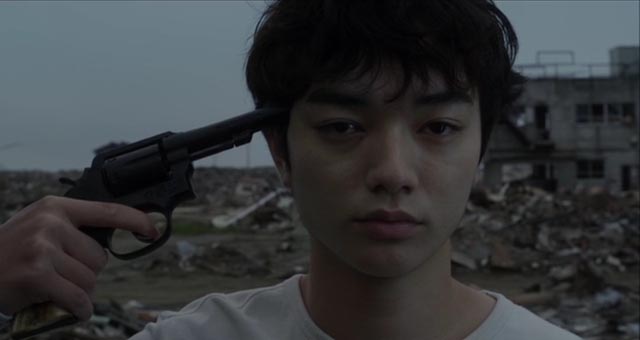
Continuing my partial round-up of recently watched movies …
The Innkeepers (Ti West, 2011)
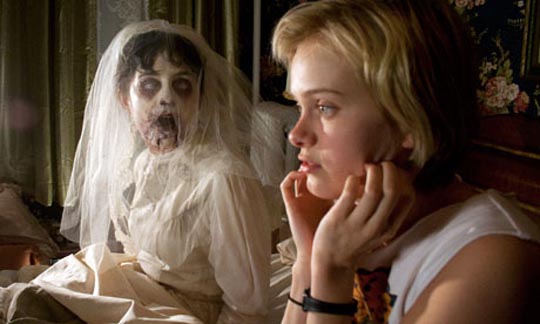
Ti West is a filmmaker whose work I really want to like, but each film comes as a letdown – except for his second feature, Trigger Man (2007), a terrific exercise in minimalist terror about three buddies out for a day of hunting who find themselves targeted by an unseen sniper. His first feature, The Roost (2005), is a run-of-the-mill story about some friends who find themselves stranded one night at a farm where vampire creatures attack out of the dark. His breakthrough, House of the Devil (2009), is a conscious throwback to ’70s-style horror, with a babysitter taking a job at a spooky old mansion where she’s targeted for some unpleasant rituals by the creepy owners. But despite getting the tone note-perfect, West’s script never transcends its B-movie inspiration.
The same can be said for his most recent feature, The Innkeepers (2011). What starts as an engaging, low-key haunted house story about a couple of friends who have the night shift on the final weekend of an old New England hotel, dealing with a couple of difficult guests and trying to make contact with the resident ghost, gradually becomes irritating as the characters start behaving in the worst B-movie way … how many times after encountering what seems to be a threatening spirit are you actually going to go alone down into the dark basement? Well, in The Innkeepers, I lost track of the number … Which is too bad, because West is skillful at setting the scene and building atmosphere; and I really do like his determination to take a traditional approach to subject and story.
In this, he’s like his producer (and mentor?) Larry Fessenden, whose own horror films exhibit a love and respect for classical storytelling. But West lacks the depth and originality which enable Fessenden to transcend the genre elements of his films and give them intellectual and emotional resonance.
The Great White Silence (Herbert G. Ponting, 1924)
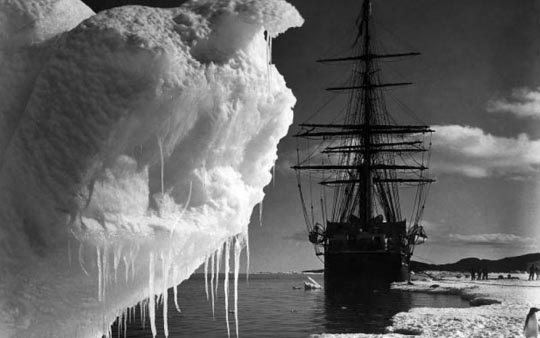
The BFI edition of The Great White Silence, the film of Captain Scott’s ill-fated Antarctic expedition of 1910-11, represents an impressive feat of restoration. The images are clear and haunting, but it quickly becomes apparent that much of the footage was staged before Scott and his men actually set off from the base camp. The later, re-edited sound version 900 South (1933) avoids this kind of falsification, explaining why and how the footage was staged to give some idea of what the men would be going through once they departed. The added narration also fills in more details than the original intertitles were able to do.
Growing up in England in the late ’50s and early ’60s, I accepted the general image of Scott as a heroic figure. But looking back, particularly in light of what we now know about the decisions he made and in contrast to the remarkable achievements of Ernest Shackleton (well-documented in George Butler’s documentary The Endurance [2000]), Scott comes across as a tarnished figure, a man whose obsession with reaching the Pole first for the glory of Empire caused him to drive his men to their deaths. When I learned from the narration that less than a day’s walk to the food stores placed at the beginning of the trek Scott had his starving, frost-bitten, exhausted men pause for a day to collect geological samples, resulting in their being caught in the storm which finally killed them just a few miles from the stores, I lost all respect for him. Although the film itself strives to present him as a heroic figure whose “sacrifice” was invaluable to science, he ends up looking like an arrogant man who callously threw away the lives of his men.
Salt of Life (Gianni Di Gregorio, 2011)
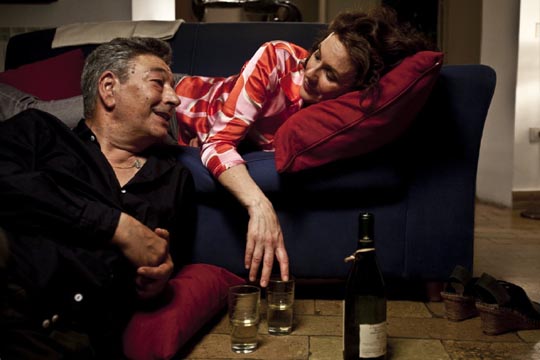
Gianni Di Gregorio’s follow-up to his wonderful Mid-August Lunch (2008), Salt of Life has much of the same charm as that first feature, but less of the substance. Continuing to document a slightly fictionalized version of himself, the director has his character Gianni obsessing over the fact that he’s reached an age at which women no longer seem to see him. This invisibility begins to undermine his sense of self-worth, triggering a melancholy contemplation of what it means to be growing old. But the film tends towards a repetition of the same point over and over again, rather than the progression we saw in Mid-August Lunch where, through the elderly women he’s gradually obliged to take care of, we get to see the continuing vitality bubbling beneath the surface of old age. In contrast to the sometimes spiky energy of those old women, the Gianni of Salt of Life ends up seeming like a short-sighted self-pitier.
Warriors of the Rainbow: Seediq Bale
(Wei Te-Sheng, 2011)
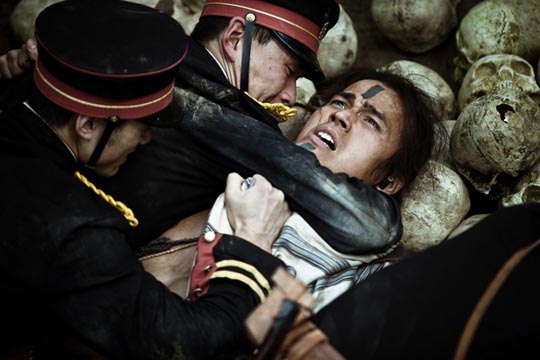
Wei Te-Sheng’s Warriors of the Rainbow: Seediq Bale, a big budget Chinese epic, tells the fascinating, little-known story of Taiwan’s indigenous tribes who, at the beginning of the 20th Century, were subjugated by the Japanese occupation of Taiwan which lasted until the end of the Second World War. Initially warring among themselves in the island’s remote mountain valleys, gaining glory through taking the heads of their enemies, the tribes are reduced to a state of slavery, used by their contemptuous Japanese overseers in the exploitation of Taiwan’s rich natural resources.
In the 1920s, some of the tribes rose up against their masters, and that rebellion is the subject of the film. Although held in contempt, their “primitive” tactics inflict a surprising amount of damage on the technologically superior forces of Japan. Interestingly, Wei doesn’t romanticize the indigenous people; their way of life was pretty brutal, their rivalries deadly, a man’s stature based on how many skulls of those he’d killed that he possessed. And even under the crushing brutality of the Japanese occupation, tribal hatreds survived, some even siding with the Japanese in order to destroy their rivals.
There are haunting images, particularly of the fate of the women and children whose presence will hinder the men’s fight. Of course, the large scale action scenes unavoidably use a lot of CG, but Wei manages to keep his focus on the characters who know that they will inevitably lose as the Japanese bring in planes and poison gas.
Himizu (Sion Sono, 2011)
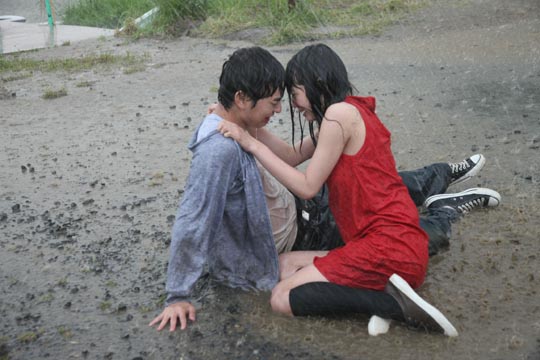
The most recent release on DVD from the prolific Sono Sion (he’s since completed several other films), Himizu continues this director’s dissection of what he sees as a society in decline. Amongst the post-tsunami debris, teenager Yuichi Sumida (Shota Sometani) lives with his slutty mother in a boat-rental shack beside a lake. Numb and inexpressive, he goes mechanically to school where he’s idolized by Keiko Chazawa (Fumi Nikaido), a girl he pays no attention to, whose own parents keep telling her to kill herself because her birth ruined their lives. When Yuichi’s alcoholic father occasionally visits, he beats the boy and takes money from him.
Eventually, Yuichi’s mother also abandons him, and he becomes the target of a yakuza boss looking to be repaid for a loan made to his father. Wanting nothing more than a quiet life renting out boats, Yuichi is pushed over the edge and decides that he must rid the world of bad people, putting on camouflage makeup and taking a big knife to the city …
In many ways, this is familiar territory for Sono, a society in which all social and familial bonds have been ruptured, where people live in a constant state of emotional pain which drives them to extreme acts … but in the small group of homeless people who camp out near the lake, and the insistent attention of Keiko, there are tentative steps towards the reestablishment of a community which is determined not to lose Yuichi to the chaos.
As usual, Sono pumps up the stylistic intensity, giving the performances a theatrical quality. But there’s an emotional reality to the two kids which anchors the ferocious emotional storms that run through the film. Although he doesn’t seem to be breaking any new ground here, and Himizu lacks the lighter charms of Love Exposure (2008), the movie is consistently involving and displays the director’s usual strong visual skills.
Comments